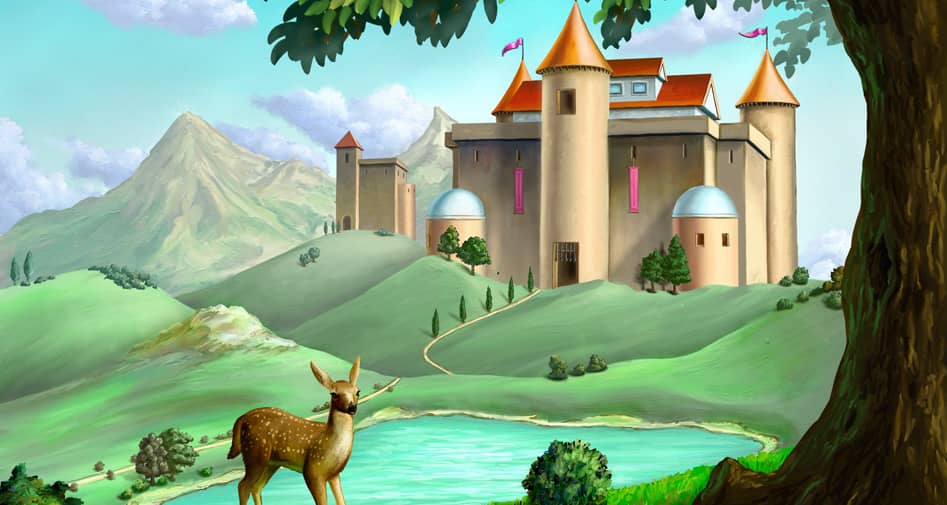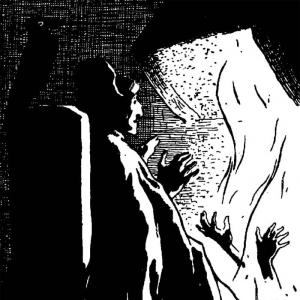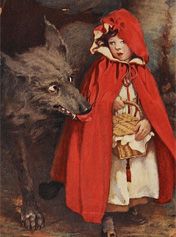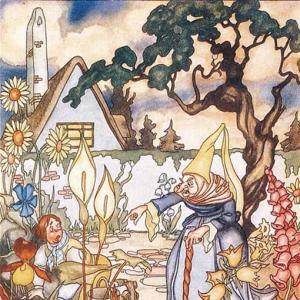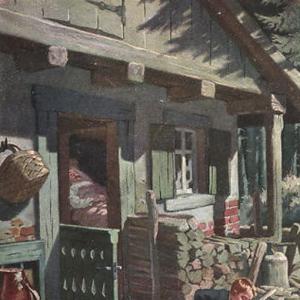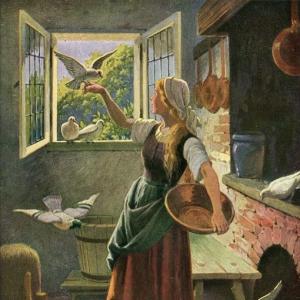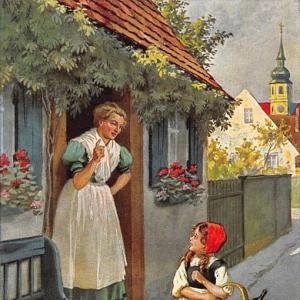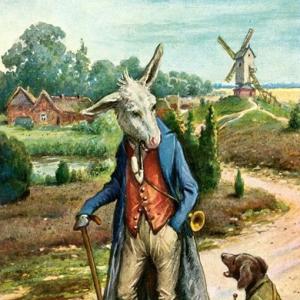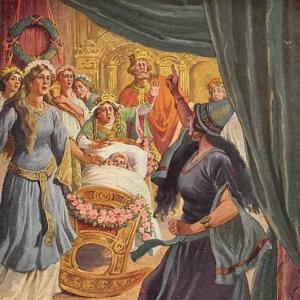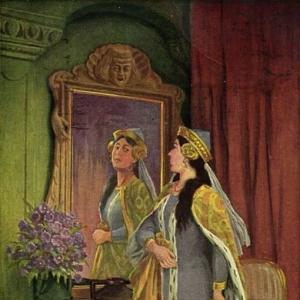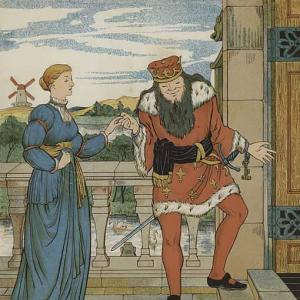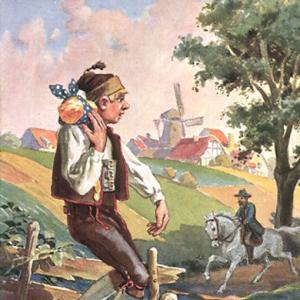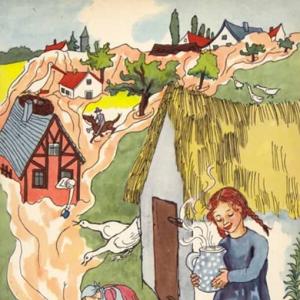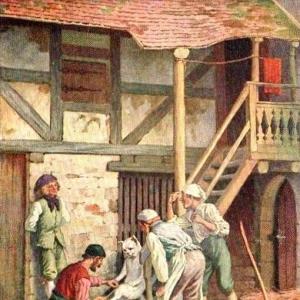Reading time for children: 3 min
In former times, when God himself still walked the earth, the fruitfulness of the soil was much greater than it is now. Then the ears of corn did not bear fifty or sixty, but four or five hundred-fold. Then the corn grew from the bottom to the very top o f the stalk, and according to the length of the stalk was the length of the ear. Men however are so made, that when they are too well off they no longer value the blessings which come from God, but grow indifferent and careless. One day a woman was passing by a corn-field when her little child, who was running beside her, fell into a puddle, and dirtied her frock. On this the mother tore up a handful of the beautiful ears of corn, and cleaned the frock with them. When the Lord, who just then came by, saw that, he was angry, and said, „Henceforth shall the stalks of corn bear no more ears; men are no longer worthy of heavenly gifts.“ The by-standers who heard this, were terrified, and fell on their knees and praye d that he would still leave something on the stalks, even if the people were undeserving of it, for the sake of the innocent birds which would otherwise have to starve. The Lord, who foresaw their suffering, had pity on them, and granted the request. So the ears were left as they now grow.
 Learn languages. Double-tap on a word.Learn languages in context with Childstories.org and Deepl.com.
Learn languages. Double-tap on a word.Learn languages in context with Childstories.org and Deepl.com.Backgrounds
Interpretations
Adaptions
Summary
Linguistics
„The Ear of Corn“ is a short fairy tale collected by the Brothers Grimm, Jacob (1785-1863) and Wilhelm (1786-1859) Grimm, who were German academics, linguists, cultural researchers, and authors. The Brothers Grimm are best known for their collection of folklore and traditional stories, which they compiled in the early 19th century. Their work, titled „Kinder- und Hausmärchen“ (Children’s and Household Tales), was first published in 1812 and went through several revisions and editions, with the final edition being published in 1857.
The tales collected by the Brothers Grimm were derived from various sources, including oral traditions, previously published works, and the stories told to them by friends and acquaintances. Their collection aimed to preserve the rich cultural heritage of Germanic folklore, which was at risk of being lost due to the process of industrialization and modernization that was taking place at the time.
„The Ear of Corn“ is one of the lesser-known tales in their collection and is categorized as a religious or didactic tale. The story is set in a time when God still walked the earth and directly interacted with humans. The tale teaches moral lessons about gratitude, appreciation, and the consequences of taking blessings for granted, while also emphasizing the importance of compassion and interconnectedness.
Although the Brothers Grimm are often associated with the romanticized versions of fairy tales that have become popular in Western culture, many of their collected stories, like „The Ear of Corn,“ contain darker themes and moral lessons that reflect the struggles and values of the people living during that time.
„The Ear of Corn“ offers several interpretations and lessons that can be drawn from its narrative. Some of the key interpretations include.
Gratitude and appreciation: The story emphasizes the importance of being grateful for the blessings we receive in life. The people’s indifference to the bountiful harvests led to the decline in the abundance of corn, which serves as a reminder to appreciate and respect the gifts we receive.
Consequences of carelessness and disrespect: The mother’s careless act of using the corn to clean her child’s frock symbolizes the lack of respect and appreciation for the gifts provided by God. This act led to the Lord’s anger and the punishment that followed, teaching readers to be mindful of their actions and how they may impact their surroundings.
Compassion and mercy: The tale also highlights the importance of compassion and mercy. The people’s plea to the Lord to spare the corn for the sake of the innocent birds demonstrates their empathy for other creatures. The Lord’s decision to grant their request showcases His mercy and willingness to forgive.
Interconnectedness of life: The story demonstrates the interconnectedness of life and the environment, as the people’s actions affected not only themselves but also the innocent birds. This serves as a reminder to be aware of our actions and their potential impact on other beings and the world around us.
The power of collective prayer and action: The people’s collective plea to the Lord led to the reversal of His initial decision, highlighting the power of unity and collective action in bringing about positive change. This can be seen as an encouragement for people to work together in order to overcome challenges and protect the environment.
„The Ear of Corn“ is a lesser-known fairy tale from the Brothers Grimm, but it has still been adapted in various forms of media. Here are a few examples of adaptations.
Children’s Books: The story has been adapted into several children’s books over the years, including „The Magic Ear of Corn“ by Margaret Hillert and „The Golden Ear of Corn“ by Virginia Kahl. These books simplify the original tale for younger readers and include illustrations to help bring the story to life.
Animated Shorts: „The Ear of Corn“ has also been adapted into several animated shorts, including one by the Grimm’s Fairy Tale Classics anime series. These adaptations often add humor and music to the story, making it more accessible to children.
Stage Productions: The tale has also been adapted for the stage. For example, in 2014, a play titled „The Golden Ear of Corn“ was performed by the Summer Theater Arts Rendezvous in Canada. The production included songs, dances, and puppetry to tell the story.
Modern Retellings: The story has also been adapted into modern retellings, such as the children’s book „The Magic Cornfield“ by Nancy Willard. These adaptations often update the story to make it more relevant to modern audiences, while still retaining the original themes and messages.
Overall, „The Ear of Corn“ may not be as well-known as other fairy tales from the Brothers Grimm, but it has still been adapted in various forms of media over the years, providing new interpretations and ways to enjoy the classic story.
„The Ear of Corn“ is a fairy tale by the Brothers Grimm that takes place in a time when God still walked the earth and the soil was extremely fertile. During this period, corn would grow in abundance, with ears that were as long as the stalks themselves, yielding four or five hundred-fold harvests. However, people took these blessings for granted and became indifferent to the gifts from God.
One day, a woman and her child were walking past a cornfield when the child accidentally fell into a puddle and dirtied her frock. The mother carelessly tore a handful of beautiful ears of corn to clean the frock. When the Lord witnessed this act of disrespect, He became angry and declared that the stalks of corn would no longer bear ears, as humans were no longer deserving of such heavenly gifts.
The people nearby, terrified by the Lord’s words, pleaded with Him to reconsider His decision for the sake of the innocent birds that would starve without the corn. Taking pity on the birds and acknowledging their potential suffering, the Lord granted their request and allowed the ears of corn to continue growing, albeit in the diminished form that is seen today. This tale serves as a reminder of the importance of being grateful for the blessings we receive and the consequences of taking them for granted.
The fairy tale „The Ear of Corn“ by the Brothers Grimm offers a rich tapestry for linguistic analysis, revealing insights into its narrative structure, themes, and the moral values it seeks to convey.
Narrative Style and Structure:
The tale is brief, following a linear narrative structure typical of many traditional fairy tales. The story begins with an exposition that sets the scene in a past era where divine presence was tangible and the earth more bountiful. The turning point or crisis occurs when a woman inadvertently disrespects this divine gift, leading to divine retribution. The resolution is found in a compromise, where God, showing mercy, allows the corn to still bear ears, albeit less abundantly. This structure highlights the moral lesson, a common feature in folklore, about the consequences of taking divine gifts for granted.
Language and Imagery:
Vivid imagery is employed to contrast the past and present states of agriculture: „the ears of corn did not bear fifty or sixty, but four or five hundred-fold,“ and „corn grew from the bottom to the very top of the stalk. “ Such descriptions evoke a sense of abundance and divine blessing. The linguistic choices underline the themes of loss and punishment, particularly with phrases like „the Lord was angry“ and „men are no longer worthy of heavenly gifts. “
Moral and Didactic Elements:
The story is didactic, a common trait in fairy tales, especially those by the Brothers Grimm. It imparts a moral lesson about human nature and divine justice. The narrative suggests that human beings tend to become complacent when overly blessed, which leads to carelessness and a lack of appreciation. The divine retribution serves as a cautionary element, promoting the value of gratitude and humility.
Characterization:
Characters in the tale are archetypal and flat, serving primarily to advance the moral rather than to develop complex personalities. The woman and her child are nameless, representing humanity in general, while the Lord is an embodiment of divine authority and justice. This lack of individual characterization is typical in fairy tales, focusing the reader’s attention on the broader moral.
Cultural and Religious Context:
The tale taps into Judeo-Christian themes with its depiction of God directly influencing human life and morals. The narrative reflects a cultural context where divine intervention was a common explanatory mechanism for natural phenomena and societal changes. The appeal at the end to spare the birds introduces an ecological dimension, recognizing interdependence within creation, which can resonate with contemporary environmental awareness.
Overall, „The Ear of Corn“ employs linguistic simplicity to deliver complex messages about gratitude, the human propensity for carelessness, and divine justice imbued with mercy. Through its structure, imagery, and economy of language, it remains an effective vehicle for moral instruction.
Information for scientific analysis
Fairy tale statistics | Value |
|---|---|
| Number | KHM 194 |
| Aarne-Thompson-Uther-Index | ATU Typ 779 |
| Translations | DE, EN, ES, PT, IT, JA, NL, PL, RU, TR, VI, ZH |
| Readability Index by Björnsson | 35.5 |
| Flesch-Reading-Ease Index | 76.3 |
| Flesch–Kincaid Grade-Level | 8.7 |
| Gunning Fog Index | 11.7 |
| Coleman–Liau Index | 8.1 |
| SMOG Index | 9.8 |
| Automated Readability Index | 9.9 |
| Character Count | 1.272 |
| Letter Count | 990 |
| Sentence Count | 10 |
| Word Count | 244 |
| Average Words per Sentence | 24,40 |
| Words with more than 6 letters | 27 |
| Percentage of long words | 11.1% |
| Number of Syllables | 305 |
| Average Syllables per Word | 1,25 |
| Words with three Syllables | 13 |
| Percentage Words with three Syllables | 5.3% |
